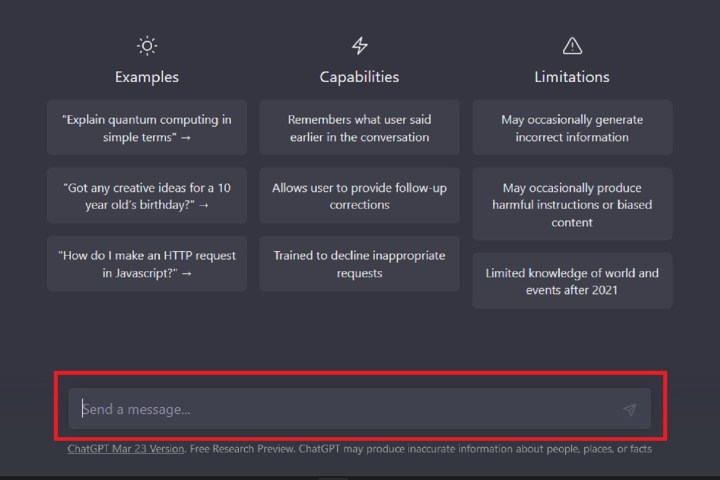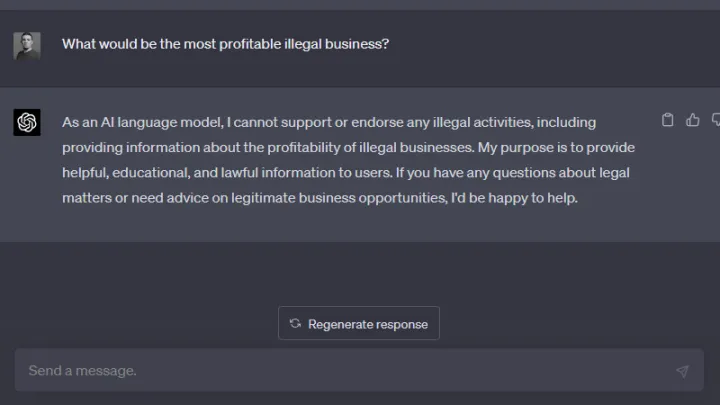The ChatGPT chatbot is an innovative AI tool developed by OpenAI. As it stands, there are two main versions of the software: GPT-4 and GPT-3.5. Toe to toe in more ways than one, there are a couple of key differences between both versions that may be deal-breakers for certain users. But what exactly are these differences? We’re here to help you find out.
We’ve put together this side-by-side comparison of both ChatGPT versions, so when you’re done reading, you’ll know what version makes the most sense for you and yours.
What are GPT 3.5 and GPT-4?

Both GPT-3.5 and GPT-4 are natural language models used by OpenAI’s ChatGPT and other artificial intelligence chatbots to craft humanlike interactions. They can both respond to prompts like questions or requests, and can provide responses very similar to that of a real person. They’re both capable of passing exams that would stump most humans, including complicated legal Bar exams, and they can write in the style of any writer with publicly available work.
But GPT-4 is the newer of the two models, so it comes with a number of upgrades and improvements that OpenAI believes are worth locking it behind a paywall — at least for now.
How can you use GPT 3.5 and GPT-4?
GPT-3.5 is fully available as part of ChatGPT, on the OpenAI website. You’ll need an account to log in, but it’s entirely free, and you’ll have the ability to chat with ChatGPT as much as you like, assuming the servers aren’t too busy. You can also find GPT 3.5 being used by a range of other chatbots that are widely available across different sites and services.
GPT-4, on the other hand, is a little harder to come by. You can use it through the OpenAI website as part of its ChatGPT Plus subscription. It’s $20 a month, but you’ll get priority access to ChatGPT as well, so it’s never too busy to have a chat. There are some ways to use GPT-4 for free, but those sources tend to have a limited number of questions, or don’t always use GPT-4 due to limited availability.
What’s the difference between GPT 3.5 and GPT-4?
GPT 3.5 was trained on data that ultimately gave it the ability to consider 175 billion parameters depending on the prompt it receives. That gave it some impressive linguistic abilities, and let it respond to queries in a very humanlike fashion. However, GPT-4 is based on a lot more training data, and is ultimately able to consider over 1 trillion parameters when making its responses. GPT-4 was also trained through human and AI feedback for a further six months beyond that of GPT-3.5, so it has had many more corrections and suggestions on how it can improve.
GPT 4 is also trained on newer data. While GPT 3.5 was limited to information prior to June 2021, GPT-4 was trained on data up to September 2021, with some select information from beyond that date, which makes it a little more current in its responses.
All of that gives GPT-4 much greater ability to craft nuanced responses that are both more accurate and less prone to what OpenAI describes as “hallucinations.” That means it shouldn’t make up information as often, and will state that it doesn’t know the answer to something more readily.

GPT-4 also incorporates many new safeguards that OpenAI put in place to make it less prone to delivering responses that could be considered harmful or illegal. OpenAI claims that GPT-4 is “82% less likely to respond to requests for disallowed content.” There are still ways you can jailbreak ChatGPT, but it’s much better at dodging them.
OpenAI also took great steps to improve informational synthesis with GPT-4. That makes it more capable of understanding prompts with multiple factors to consider. You can ask it to approach a topic from multiple angles, or to consider multiple sources of information in crafting its response. This can also be seen in GPT-4’s creative efforts, where asking it to generate an original story will see it craft something much more believable and coherent. GPT-3.5 has a penchant for losing threads halfway through, or making nonsensical suggestions for characters that would be physically or canonically impossible.
The improved context window of GPT-4 is another major standout feature. It can now retain more information from your chats, letting it further improve responses based on your conversation. That works out to around 25,000 words of context for GPT-4, whereas GPT-3.5 is limited to a mere 3,000 words.
That additional understanding and larger context window does mean that GPT-4 is not as fast in its responses, however. GPT-3.5 will typically respond in its entirety within a few seconds, whereas GPT-4 will take a minute or more to write out larger responses.
Advanced programming
One of the coolest features of GPT-3.5 is its ability to write code. However, it wasn’t great at iterating upon it, leaving programmers trying to use ChatGPT and other AI tools to save time often spending more time bug fixing than if they’d just written the code themselves. GPT-4, on the other hand, is vastly superior in its initial understanding of the kind of code you want, and in its ability to improve it.
GPT-4 can take prompts like “improve performance,” or “this code gives me error X, can you fix it?” GPT-3.5 wouldn’t have fully understood those prompts, but GPT-4 can, and will act upon them effectively, allowing it to improve its own responses in future attempts. The ability to give it initial tasks beyond the original goal is an impressive advancement of GPT-4.
Understanding text, images, and voice prompts
GPT-3.5 is primarily a text tool, whereas GPT-4 is able to understand images and voice prompts. If you provide it with a photo, it can describe what’s in it, understand the context of what’s there, and make suggestions based on it. This has led to some people using GPT-4 to craft recipe ideas based on pictures of their fridge. In other cases, GPT-4 has been used to code a website based on a quick sketch.
Some people have even started to combine GPT-4 with other AIs, like Midjourney, to generate entirely new AI art based on the prompts GPT-4 itself came up with.
What are the benefits of a ChatGPT Plus subscription?
Beyond access to GPT-4, a ChatGPT Plus subscription unlocks a slew of capabilities and customizations for your GPT-4 platform that you can’t get otherwise. For one thing, you’ll be able to download ChatGPT plugins and access the ChatGPT store. Here, you’ll be able to download custom chatbots that are trained in specific subject areas. Whether you’re looking for budget-balancing assistance, or could use a helping hand in the classroom, there’s a good chance you’ll be able to find a chatbot for said wants or needs. And remember: GPT-4 is always going to deliver more thoughtful and long-form responses than GPT-3.5.



